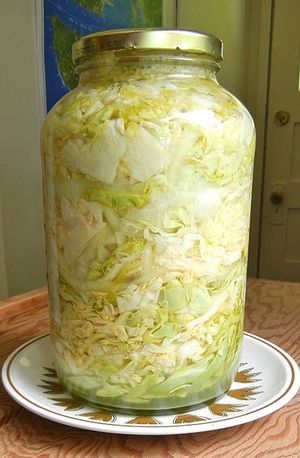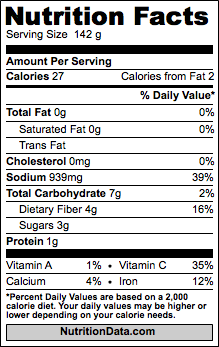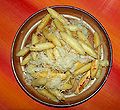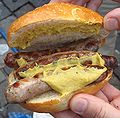Course:FNH200/2013w Team05 Sauerkraut
Introduction
Sauerkraut is a popular side dish in German and European cuisine. It can be eaten straight out of the jar, or heated up and sprinkled on top of your favorite hotdog. Most of us can easily identify sauerkraut from its very distinct aroma and flavor. It is often an acquired taste for many people. Most of us know sauerkraut comes from cabbage, but not much else. In this article we will answer a wide range of questions regarding this unique dish. Where did sauerkraut originate from? How is it made? What role does fermentation play in the preservation of sauerkraut? Does the government have any regulations regarding the production of sauerkraut? What are some of the health benefits and risk from consuming sauerkraut? Can I make it at home? These are just some of the questions we will be exploring in this article in order to have a better understanding of sauerkraut.

History and Cultural Aspects

The world "sauerkraut" is a German word, when translated into English means "sour cabbage."[1] It is then no wonder why so many people associate sauerkraut with Germany. However, sauerkraut and other fermented cabbage products were not actually first produced in Europe, but rather in ancient China some 2,000 years ago.[2] It is said that during the construction of the Great Wall of China, builders uses to live off of cabbage and rice.[2] During the winter months they added rice wine to sliced up cabbage in order preserve it, thus leading to fermentation of the cabbage producing the very first instance of sauerkraut.[2] Sauerkraut was introduced to the Europeans by Tartars, who carried it in their saddlebags to Europe, a thousand years later after Genghis Khan invaded China.[3] Once in Europe, instead of using rice wine, the Germans preserved it by salting the shredded cabbage, which is why there is a significant about water at the bottom of storage jars that is drawn out of the cabbage.[2] Sauerkraut became a food stable in medieval Europe as it was an excellent source of nutrition and was easily preserved for long periods of time without the need for refrigeration.[4] During the 18th century explorers such as James Cook took stores of sauerkraut on their ocean voyages due to sauerkraut's high vitamin C content for preventing scurvy among their crew members.[3] In the 20th century following the start of World War I and World War II allied soldiers used the term "kraut" from the word "sauerkraut" as a derogatory term for German soldiers.[4]
Production and Processing
Ingredients
Salt is added to many fermented foods for various reasons and the amount of salt added depends on the preference of the consumer and the type of vegetable being fermented. In the production of sauerkraut, salt helps fluid to be released from the shredded cabbage, creating an anaerobic condition. The addition of salt will favor the growth of lactic acid bacteria and prevent the growth of spoilage-causing bacteria and fungi. Heterofermentative lactic acid bacteria prefer a low salt concentration of about 1% and cannot grow well in a concentration of 3%. On the other hand, homofermentative lactic acid bacteria prefer higher a salt concentration which helps accelerate fermentation. Salt content below 0.8% results in soft sauerkraut which is the result of undesirable fermentation. [5]
Homemade Sauerkraut
Any kind of cabbage can be used when making sauerkraut at home. Green, red, savoy, napa or any other variety and in any combination. The steps are simple[6]:
1. Shred the cabbage.
2. Put the cabbage shreds in a glass or ceramic crock.
3. Sprinkle salt onto the shreds(~3 tablespoons salt/5 pounds of cabbage).
4. Mix the salt in and let the cabbage stand for about an hour.
5. Let it wilt and compact the shreds by pushing it and weighing it down.
6. Cover the whole container with a towel to keep dust and other things out of the container.
7.Let it ferment for about 4-6 weeks under room temperature.
8. Enjoy!
The yield is about 1 gallon sauerkraut per 5 pounds of cabbage.[7] To ensure high quality homemade sauerkraut, it is necessary to check it frequently. The maturation rate is about a few weeks' time or more. Tasting is the only way to tell whether it is ready or not. Cabbages are usually planted in the spring and harvested in the fall; these cabbages are juicier than the ones which are planted in the fall.
Commercial Sauerkraut
Commercial Sauerkraut is generally pasteurized and then packaged in a brine of extremely salty water. The best way to prepare commercial sauerkraut is to rinse it well under running water while squeezing out the brine. This gets rid of excess salt and mutes the unpleasant taste of the commercial brine, which in addition to salt often has vinegar along with other additives. Commercial Sauerkraut is best served cooked. Pasteurized commercial sauerkraut has none of the beneficial probiotics or enzymes of homemade sauerkraut but it is still plentiful in nutrients and is a healthy food when properly rinsed and prepared.[8]
Fermentation Procedure
Unlike fermented dairy and meat products where a starter cultures are needed, traditional sauerkraut has spontaneous fermentation. Traditional sauerkraut fermentation can be divided into four general stages.
The first stage, which lasts for three days, consists of the cabbages being chopped and placed into vessels to start fermentation. In commercial processing a vessel can contain 100 tons of chopped cabbage. Salt is added until an equilibrium concentration of 2% is achieved. The osmotic effect from the salt creates a liquid separation from the cut cells which acts as a first medium for microorganisms. An anaerobic environment is created by covering the cabbage with a plastic sheet and filling water on top of the plastic . Under the anaerobic environment, aerobic bacteria begin to decrease in number while facultatively anaerobic enterobacteria grow during the first 2 or 3 days. Also, dissolved oxygen is consumed while carbon dioxide and heat are released as a result of the respiration processes of the plants and the microorganisms. Lactic, acetic, formic and succinic acids are formed, which lowers the overall pH, and foam may be created by carbon dioxide.[5] [9]
In the second stage, with increased acid concentration and decreased oxygen content, microaerophylic lactic acid producers thrive in the environment and Lactobacillus mesenteroides starts lactic acid fermentation. Furthermore, the cabbage contains about 4% to 5% sugar consisting in a 1:1 ratio of glucose and fructose. These sugars are converted to lactic acid by heterofermentative lactic acid bacteria called Leuconostoc mesenteroides and Lactobacillus buevis. This takes 3 to 6 days to happen and at the end the lactic acid concentration increases by 1%. [5] [9]
In the third stage, homofermentative lactic acid bacteria take over the fermentation process because of the changes in the environment, such as the absence of oxygen, the low pH and the high salt content. While this environment allows L. plantarum to grow, an increase of the total acid content from 1.5% to 2.0% would inhibit its growth. The sauerkraut can be pasteurized once the pH is in the range of 3.8 to 4.1. [5] [9]
During the fourth stage, Lactobacillus buevis and other heterofermentative lactic acid bacteria, such as Pediococcus and Enterococcus, metabolize pentoses from the breakdown of cell walls, which increases the acid content to 2.5% and the pH is lowered to 3.8-3.6.[5] [9]
Fermentation Engineering
Lactobacillus is the major genus strain of bacteria in fermented Sauerkraut. However, lactic acid bacteria is the endemic species found on raw vegetables. Spontaneous fermentations result from competition of endemic species and other microorganisms, where those who are adapted to the fermented environment prevail. The spontaneous process takes a long time and has a high risk of failure; the failure of the fermentation process leads to spoilage and the growth of pathogens. The presence of lactic acid bacteria inspired the use of starter cultures. Lactobacillus strains are used to speed up the acidification process, inhibit the growth of spoilage microorganisms and shorten the length of the fermentation process. [10]
Metabolism
Lactic acid bacteria (LAB) comprise the most diverse bacteria group and they are the main drivers behind the fermentation process of sauerkraut. Strains in the genus belong to two groups – homofermenters and heterofermenters. Sauerkraut, the end product, contains lactic acid from both groups, which are obtained through different pathways of lactic acid production.
Homofermentative LAB produce lactic acid via a process where one mole of glucose is catabolized by the Embden-Meyerhof glycolytic pathway into two moles of pyruvate. The maintenance of intracellular redox balance leads to the reduction of the pyruvate into lactic acid [11].
C6H12O6 → 2CH3CHOCOOH
Heterofermentative LAB produce lactic acid, ethanol, acetate, and carbon dioxide through the 6-phosphoglucanate/phosphoketolase pathway. In heterolactic fermentation, one mole of glucose is converted into one mole of lactic acid, one mole of ethanol and one mole of carbon dioxide. [10]
C6H12O6 → CH3 CHOCOOH + C2H5OH + CO2
Control of Fermentation
To stimulate the growth of desirable organisms for the fermentation, the concentration of oxygen, the temperature, the pH and inhibitors must be altered to ensure that desired microorganisms grow while spoilage microorganisms are inhibited.
Low Concentration of Oxygen
Microorganisms can be categorized on different temperature ranges and oxygen requirements. Aerobic bacteria grow in the presence of dissolved oxygen and anaerobic bacteria grow in the absence of dissolved oxygen. Facultative anaerobe bacteria can grow in the presence or absence of oxygen. Microarophilic bacteria grow in reduced amounts of oxygen. Therefore, controlling the amount of free oxygen can allow only desired bacteria to survive. Fermentation of sauerkraut is an anaerobic process. Fungi do not grow well in an anaerobic environment and dominant organisms in fermented vegetables do not grow well if there is a low amount of available oxygen. LAB are microarophilic or facultative anaerobic, hence reducing oxygen can ensure that the cabbage is fermented by lactic acid. [10]
Temperature
The range of temperature required for Sauerkraut processing is 15 degree Celsius to 20 degree Celsius. A few degrees variation from this range can alter the type of bacteria growth, which will affect the final quality. The optimum temperature for Leuconostoc mesenteroides to grow is 20 degree Celsius and this temperature is also the most desirable to initiate fermentation. [12]
pH
Generally, pH is not controlled, except for special purposes, as the environment becomes more acidic due to the production of lactic acid by LAB during fermentation. However, having the right pH will ensure the product to have a good shelf life because most spoilage microorganism cannot survive in an acidic or alcoholic environment. pH controlled fermentation offers microbiological stability during a storage period of 12 months at 24 degrees Celsius.[10]
Inhibitors
Bacteriocins or bacteriocin like substances synthesized by Lactobacillus strains are called inhibitors, which are used to inhibit lactobacilli from over ripening the cabbage. It does not prevent the growth of spoilage microorganism during the fermentation process.[10]
Packaging
Regulation and Labelling
All sauerkraut products sold in Canada must follow the CFIA requirements on food labeling for industry. Under Processed Products Regulations Part 4, sauerkraut products must be labelled with " the words “keep refrigerated” if the product is sauerkraut with preservative."[13]
Standards of Food Identity and Composition
In Canada standards of food identity and composition are defined in the Food Regulations of the Food and Drugs Act of Canada.[14] While many food products are defined in the regulations, sauerkraut falls under Processed Products Regulations C.R.C., c. 291, which regulates grading, packing and making of processed products does apply to processed sauerkraut.[15] As stated in the Standards of Identity for Specified Fruit and Vegetable Products, sauerkraut is defined as “Sauerkraut with Preservative.”[16] Under this definition sauerkraut is a "product obtained by the fermentation of properly prepared and shredded cabbage to which salt has been added and to which is added one of the following preservatives or a salt thereof and that is not heat processed:benzoic acid, sorbic acid, sulphurous acid; may contain water, salt, spices, seasoning, other natural flavouring ingredients to give the product a specific flavour characteristic, and lactic acid."[17]
Under Processed Products Regulations the law sets out that "sauerkraut is the product obtained by the full natural fermentation of properly prepared and shredded cabbage to which salt is added and, upon completion of fermentation, contains not less than one per cent acid, expressed as lactic."[18] In regards to measuring acidity regulations state that it must be "expressed as lactic, shall be determined by direct titration with standard tenth normal sodium hydroxide solution, using phenolphthalein to indicate the end point" Lastly, processed product regulations allow sauerkraut to be "packed with other natural flavouring ingredients to give the product a specific flavour characteristic."[19]
Food Grades Standards
Like many other products Canada regulates food grades standards for sauerkraut which are administered by the Canadian Food Inspection Agency (CFIA) under the Canadian Agricultural Products Standards Act. These grading standards fall under the Processed Products Regulations and provide two grade standards for Sauerkraut called "Canada Fancy" and "Canada Choice."[20]
Canada Fancy: "is the name for the grade of sauerkraut that possesses a good well developed kraut flavour; that possesses a uniform light straw colour; that is crisp and firm; shreds well when cut to approximately 1/16 inch in thickness and is practically free from large pieces of core, heavy mid ribs, large pieces of leaves, blemishes and other defects."[21]
Canada Choice: "is the name for the grade of sauerkraut that possesses a good normal kraut flavour; that possesses a fairly good light straw colour; that is reasonably crisp and reasonably firm; shreds fairly evenly when cut to approximately 1/16 inch in thickness and is fairly free from large pieces of core, heavy mid ribs, large pieces of leaves, blemishes and other defects."[22]
Nutrition and Health Effects
Nutrition Facts

The image on the right shows the nutritional values per 142g of canned/packaged sauerkraut consumed. Sauerkraut is low in saturated and trans fat and is also low in cholesterol. It is a good source of dietary fiber and vitamin C but is very high in sodium.
Health Benefits
Since sauerkraut is made up mainly of cabbage and other cruciferous vegetables, it retains all of the health benefits of those vegetables. Before being fermented, they are high in vitamin A and C. Studies have proven that cruciferous vegetables can reduce cholesterol levels. Cabbage is also a rich source of phytonutrient antioxidants and has anti-inflammatory properties that might be helpful in fighting cancer cells[23].
Cruciferous vegetables give even more health benefits when they are fermented. The juice extracted from the cabbage helps the human body prevent intestinal infections. Once fermented, a substance called isothiocyanates is produced and it is known to prevent the growth of carcinogens. It is also used to increase the healing rate of peptic ulcers as the cabbage juice has S-methylmethionine, which is also known as vitamin U[24]. Lastly, lactic acid bacteria, by-products of the fermentation process, give healing benefits as well[25]. Without these bacteria, the human colon would be filled with harmful parasites and could lead to a condition called candida.
Health Risks
Although sauerkraut gives a lot of health benefits, either from the fermentation process or from the original ingredients, it also has some health risks if it is consumed in excess. Cruciferous vegetables contain a high level of goitrogens which are substances that prevent iodine uptake by the thyroid gland and the rest of the body. As a result, it can lead to an enlargement of the thyroid; the swelling is known as a goiter. The fermentation process requires salt, which remains in the final product. Consuming sauerkraut will easily put a consumer over the recommended daily intake of sodium. Cabbage also contains raffinose, a plant sugar that cannot be broken down by human intestine. As a result, the bacteria in a human colon will ferment the sugar once it reaches the colon, thus releasing gas. Therefore, consuming a large amount of sauerkraut will increase the amount of intestinal gas and will also cause bloating of the abdomen. Excess consumption of sauerkraut will also leave unfermented raffinose, which increases the amount of water in the large intestine, and could potentially lead to diarrhea and abdominal cramps[26]. On top of that, potential mistakes could be done during the fermentation process which could lead to other health risks.
Allergies
There is no specific allergy that could be caused by cabbage specifically. However, individuals who are prone to hives could worsen their skin condition if they consume cruciferous vegetables. Therefore, people who have hives should not consume cruciferous vegetables such as cabbage, broccoli, cauliflower, etc., as those are high in salicylate[27].
Sensory Properties
Appearance

Sauerkraut is yellowish-white in colour. It appears to be limp and soggy in structure and it has an uneven but soft texture. Sauerkraut is usually submersed in a clear yellowish-white liquid.
Aroma and Taste
A study from North Carolina State University [28] examined the differences in aroma and taste across various commercial sauerkraut products by recording the responses of their tested volunteers. “Sauerkraut samples were evaluated for aroma, flavor, and after-taste using a flavor profile panel of six to eight people trained to evaluate intensity attributes for both commercial canned sauerkraut and raw cabbage... The notes for aroma, flavor, and after-taste... [are rated on] a scale of 0 (not present) to 14 (strong).”
Sauerkraut has a unique and distinct aroma. It is very strong, sharp, and sour, but not wholly unpleasant. As one can observe from table 4, the panelists who were used for the study consistently described the sauerkrauts as having a sour and sulfuric aroma.
Moreover, the results of the recorded measurements have shown that "...overall, the sour, sulfur, and salt notes had the greatest impact in the panelist's mouth and received the highest intensity scores... The sulfur scores for aroma were significantly different... among lots."
Traditional Sauerkraut Dishes
-
Reuben Sandwich
-
Bratwurst
-
Schupfnudeln
-
Fränkische Bratwurst
Similar Foods
Kimchi
Kimchi, also known as kimchee or gimchi, is a traditional fermented side dish made of vegetables from Korea. Similar to sauerkraut, this dish is commonly found made out of napa cabbage. Different seasoning flavours are added to the fermented vegetable to give the spicy or sour taste. Kimchi is said to have high concentration of dietary fiber while being low in calories. [29]
Suan Cai
Suan cai is known as the Chinese sauerkraut, which is a traditional pickled Chinese cabbage. The production of this pickled vegetable from China is different from sauerkraut even though it has the basic fermentation process.[30]
Curtido
Curtido is also a fermented cabbage relish, typically found in Salvadoran cuisine or other Central American countries. It is usually made with cabbage, onions, carrots, and sometimes lime juice. [31]
Fun Facts About Sauerkraut
Potential Exam Question
Question: Sauerkraut and a variety of products are produced through the process of fermentation. What is unique about the fermentation process of traditional sauerkraut versus products such as yogurt or sourdough bread?
Answer: Unlike yogurt or sourdough bread, which require starter cultures, sauerkraut's fermentation process occurs spontaneously. The bacteria needed for the fermentation process of sauerkraut are already found on the raw cabbage.
References
- ↑ Food History. (2013). The History of Sauerkraut. Retrieved from http://kitchenproject.com/history/sauerkraut.htm
- ↑ 2.0 2.1 2.2 2.3 Toronto, Ont;(1980). "The Globe and Mail". 2:251-252, ISBN 03190714. Cite error: Invalid
<ref>tag; name "For sauerkraut, thank the Chinese" defined multiple times with different content - ↑ 3.0 3.1 USA;Kelly, Shirley Sieving;(2013). "Countryside & Small Stock Journal".
- ↑ 4.0 4.1 Washington, United States;(1997). "Europe". ISSN 01914545.
- ↑ 5.0 5.1 5.2 5.3 5.4 Montville, TJ; Matthews, RK (2008). "Food Microbiology: An Introduction". 2:251-252, ISBN 9781-1-55581-396-3. Cite error: Invalid
<ref>tag; name "Salt" defined multiple times with different content - ↑ wikiHowToDoAnything. (2013). Sauerkraut. Retrieved from http://www.wikihow.com/Make-Sauerkraut
- ↑ Food Safety. (2010). Sauerkraut Receipt. Retrieved from http://www.extension.umn.edu/food/Food-Safety/preserving/vegetables-herbs/sauerkraut-recipe/
- ↑ FoodBlog. (2013). How to Make Sauerkraut. Retrieved from http://daveonfood.blogspot.ca/2013/04/sauerkraut.html
- ↑ 9.0 9.1 9.2 9.3 Halasz, A; Barath, A; Holzapfel, WH (1999). "The influence of starter culture selection on sauerkraut fermentation", 208:434-438.
- ↑ 10.0 10.1 10.2 10.3 10.4 Fang, F; (2013). "Chapter 7: Fermented Vegetables", In Chen, Jian; Zhu, Yang "Solid state fermentation for foods and beverages", p. 199-216, ISBN 978-1-4398-4497-7. Cite error: Invalid
<ref>tag; name "engineering" defined multiple times with different content - ↑ Today's Online Textbook of Bacteriology. (2012). Lactic Acid Bacteria. Retrieved from http://textbookofbacteriology.net/lactics_2.html
- ↑ Edyta, MP,(2012). "Fermentation Effects on food properties" DOI: 10.1201/b11876-11
- ↑ Justice Laws Website. (2014). Processed Products Regulations (C.R.C., c. 291). Retrieved from http://laws-lois.justice.gc.ca/eng/regulations/C.R.C.,_c._291/FullText.html
- ↑ Justice Laws Website. (2014). Processed Products Regulations (C.R.C., c. 291). Retrieved from http://laws-lois.justice.gc.ca/eng/regulations/C.R.C.,_c._291/FullText.html
- ↑ Justice Laws Website. (2014). Processed Products Regulations (C.R.C., c. 291). Retrieved from http://laws-lois.justice.gc.ca/eng/regulations/C.R.C.,_c._291/FullText.html
- ↑ Justice Laws Website. (2014). Processed Products Regulations (C.R.C., c. 291). Retrieved from http://laws-lois.justice.gc.ca/eng/regulations/C.R.C.,_c._291/FullText.html
- ↑ Justice Laws Website. (2014). Processed Products Regulations (C.R.C., c. 291). Retrieved from http://laws-lois.justice.gc.ca/eng/regulations/C.R.C.,_c._291/FullText.html
- ↑ Justice Laws Website. (2014). Processed Products Regulations (C.R.C., c. 291). Retrieved from http://laws-lois.justice.gc.ca/eng/regulations/C.R.C.,_c._291/FullText.html
- ↑ Justice Laws Website. (2014). Processed Products Regulations (C.R.C., c. 291). Retrieved from http://laws-lois.justice.gc.ca/eng/regulations/C.R.C.,_c._291/FullText.html
- ↑ Justice Laws Website. (2014). Processed Products Regulations (C.R.C., c. 291). Retrieved from http://laws-lois.justice.gc.ca/eng/regulations/C.R.C.,_c._291/FullText.html
- ↑ Justice Laws Website. (2014). Processed Products Regulations (C.R.C., c. 291). Retrieved from http://laws-lois.justice.gc.ca/eng/regulations/C.R.C.,_c._291/FullText.html
- ↑ Justice Laws Website. (2014). Processed Products Regulations (C.R.C., c. 291). Retrieved from http://laws-lois.justice.gc.ca/eng/regulations/C.R.C.,_c._291/FullText.html
- ↑ Natural News. (2011). Sauerkraut offers a spectrum of health benefits. Retrieved from http://www.naturalnews.com/033659_sauerkraut_health_benefits.html
- ↑ Mother Nature Network. (2014). Surprising health benefits of sauerkraut. Retrieved from http://www.mnn.com/food/healthy-eating/blogs/surprising-health-benefits-of-sauerkraut
- ↑ Healthy Eating. What Are the Health Benefits of Sauerkraut as a Fermented Food?. Retrieved from http://healthyeating.sfgate.com/health-benefits-sauerkraut-fermented-food-8989.html
- ↑ Live Strong. (2013). Can You Eat Too Much Sauerkraut?. Retrieved from http://www.livestrong.com/article/463167-can-you-eat-too-much-sauerkraut/
- ↑ Live Strong. (2011). I Have Hives Due to Cruciferous Vegetables. Retrieved from http://www.livestrong.com/article/506886-i-have-hives-due-to-cruciferous-vegetables/
- ↑ Department of Food Science, North Carolina State University. (1995). Chemical and Sensory Characterization of Commercial Sauerkraut. Retrieved from http://fbns.ncsu.edu/USDAARS/Acrobatpubs/P254-286/P258.pdf
- ↑ Wikipedia. (2012). Kimchi. Retrieved from http://en.wikipedia.org/wiki/Kimchi
- ↑ Wikipedia. (2012). Suan Cai. Retrieved from http://en.wikipedia.org/wiki/Suan_cai
- ↑ Wikipedia. (2012). Curtido. Retrieved from http://en.wikipedia.org/wiki/Curtido



